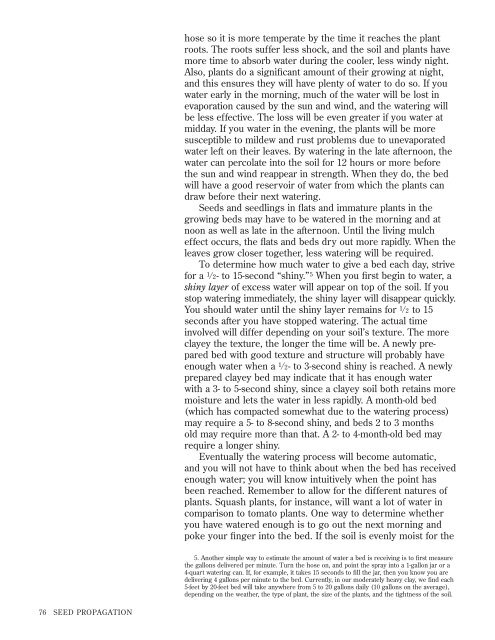How to Grow More Vegetables : And Fruits, Nuts ... - Shroomery
How to Grow More Vegetables : And Fruits, Nuts ... - Shroomery
How to Grow More Vegetables : And Fruits, Nuts ... - Shroomery
You also want an ePaper? Increase the reach of your titles
YUMPU automatically turns print PDFs into web optimized ePapers that Google loves.
76 SEED PROPAGATION<br />
hose so it is more temperate by the time it reaches the plant<br />
roots. The roots suffer less shock, and the soil and plants have<br />
more time <strong>to</strong> absorb water during the cooler, less windy night.<br />
Also, plants do a significant amount of their growing at night,<br />
and this ensures they will have plenty of water <strong>to</strong> do so. If you<br />
water early in the morning, much of the water will be lost in<br />
evaporation caused by the sun and wind, and the watering will<br />
be less effective. The loss will be even greater if you water at<br />
midday. If you water in the evening, the plants will be more<br />
susceptible <strong>to</strong> mildew and rust problems due <strong>to</strong> unevaporated<br />
water left on their leaves. By watering in the late afternoon, the<br />
water can percolate in<strong>to</strong> the soil for 12 hours or more before<br />
the sun and wind reappear in strength. When they do, the bed<br />
will have a good reservoir of water from which the plants can<br />
draw before their next watering.<br />
Seeds and seedlings in flats and immature plants in the<br />
growing beds may have <strong>to</strong> be watered in the morning and at<br />
noon as well as late in the afternoon. Until the living mulch<br />
effect occurs, the flats and beds dry out more rapidly. When the<br />
leaves grow closer <strong>to</strong>gether, less watering will be required.<br />
To determine how much water <strong>to</strong> give a bed each day, strive<br />
for a 1 ⁄ 2- <strong>to</strong> 15-second “shiny.” 5 When you first begin <strong>to</strong> water, a<br />
shiny layer of excess water will appear on <strong>to</strong>p of the soil. If you<br />
s<strong>to</strong>p watering immediately, the shiny layer will disappear quickly.<br />
You should water until the shiny layer remains for 1 ⁄ 2 <strong>to</strong> 15<br />
seconds after you have s<strong>to</strong>pped watering. The actual time<br />
involved will differ depending on your soil’s texture. The more<br />
clayey the texture, the longer the time will be. A newly prepared<br />
bed with good texture and structure will probably have<br />
enough water when a 1 ⁄ 2- <strong>to</strong> 3-second shiny is reached. A newly<br />
prepared clayey bed may indicate that it has enough water<br />
with a 3- <strong>to</strong> 5-second shiny, since a clayey soil both retains more<br />
moisture and lets the water in less rapidly. A month-old bed<br />
(which has compacted somewhat due <strong>to</strong> the watering process)<br />
may require a 5- <strong>to</strong> 8-second shiny, and beds 2 <strong>to</strong> 3 months<br />
old may require more than that. A 2- <strong>to</strong> 4-month-old bed may<br />
require a longer shiny.<br />
Eventually the watering process will become au<strong>to</strong>matic,<br />
and you will not have <strong>to</strong> think about when the bed has received<br />
enough water; you will know intuitively when the point has<br />
been reached. Remember <strong>to</strong> allow for the different natures of<br />
plants. Squash plants, for instance, will want a lot of water in<br />
comparison <strong>to</strong> <strong>to</strong>ma<strong>to</strong> plants. One way <strong>to</strong> determine whether<br />
you have watered enough is <strong>to</strong> go out the next morning and<br />
poke your finger in<strong>to</strong> the bed. If the soil is evenly moist for the<br />
5. Another simple way <strong>to</strong> estimate the amount of water a bed is receiving is <strong>to</strong> first measure<br />
the gallons delivered per minute. Turn the hose on, and point the spray in<strong>to</strong> a 1-gallon jar or a<br />
4-quart watering can. If, for example, it takes 15 seconds <strong>to</strong> fill the jar, then you know you are<br />
delivering 4 gallons per minute <strong>to</strong> the bed. Currently, in our moderately heavy clay, we find each<br />
5-feet by 20-feet bed will take anywhere from 5 <strong>to</strong> 20 gallons daily (10 gallons on the average),<br />
depending on the weather, the type of plant, the size of the plants, and the tightness of the soil.












